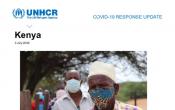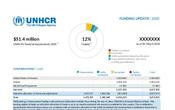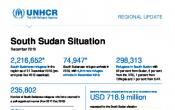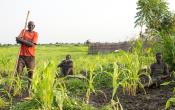Kenya
Operation: Kenya
Location
{"longitude":38,"latitude":0,"zoom_level":0,"iso_codes":"'KEN'"}
By clicking on the icons on the map, additional information is displayed.
The boundaries and names shown and the designations used on this map do not imply official endorsement or acceptance by the United Nations.
Key Figures
| 2019 year-end results | |
| 100% | of refugees had access to primary health care services with over 8,000 households enrolled in the National Health Insurance Fund. |
| 107,750 | refugees were enrolled in primary schools across the country, representing 50% of school-aged children. |
| 27,130 | new arrivals were registered by the Refugee Affairs Secretariat. |
| 2,330 | individuals were assisted to return to their countries of origin. |
| 2020 planning figures | |
| 100% | of people of concern will be registered on an individual basis with minimum set of data required |
| 100% | of refugees opting for voluntary repatriation receive return packages |
| 100% | of people of concern will have access to primary health-care services |
| 100% | of SGBV survivors receive appropriate support |
| 80% | of school-age refugee children are enrolled in early childhood and primary education |
Latest Updates and Related Links
People of Concern
4%
Increase in
2019
2019
| 2019 | 508,247 |
| 2018 | 490,224 |
| 2017 | 506,915 |

[["Refugees",438901],["Asylum-seekers",50846],["Stateless",18500]]
Loading ...
Kenya
< Back
2019
{"categories":[2015,2016,2017,2018,2019,2020],"budget":[251.196113504,269.17496251,230.28834267599998,191.11337188,169.97106229,164.64758926],"expenditure":[101.0363817,124.33198299,121.04733519,102.55652278,99.94008417,null]}
{"categories":[2015,2016,2017,2018,2019,2020],"p1":[250.824697504,268.67496278,229.378158795,190.63187567,169.41507253,164.12305225999998],"p2":[0.371416,0.49999973,0.910183881,0.48149621000000004,0.55598976,0.524537],"p3":[null,null,null,null,null,null],"p4":[null,null,null,null,null,null]}
{"categories":[2015,2016,2017,2018,2019,2020],"p1":[100.84664123,124.06368063,120.55286739,102.17128776,99.70146201,null],"p2":[0.18974047,0.26830235999999996,0.4944678,0.38523502000000004,0.23862216,null],"p3":[null,null,null,null,null,null],"p4":[null,null,null,null,null,null]}
Loading ...
CHOOSE A YEAR
- 2014
- 2015
- 2016
- 2017
- 2018
- 2019
- 2020
Operational context
In 2019, the protection environment in Kenya remained stable, albeit with some challenges.The Government of Kenya renewed the decision to close Dadaab refugee camp by August 2019 and UNHCR updated the 2016 “Plan of action for Dadaab closure” to work on solutions. Non-Somali refugees were relocated from Dadaab to Kakuma and over 4,000 Ethiopian refugees expressed a willingness to repatriate, which was scheduled to commence in 2020.
Kenya remained the only country in the region providing asylum and support to refugees with claims based primarily on their LGBTI status.
The Government also remained committed to resolving statelessness, including by making progress in honouring its pledges to grant citizenship to the Shona community by 2020, and acceding to the two statelessness conventions by 2021.
Population trends
The country remained home to some 489,700 refugees and asylum-seekers, and approximately 18,500 stateless persons. The country also received more than 27,100 new arrivals mainly from the Democratic Republic of Congo (DRC), Somalia and South Sudan over the course of the year.Some 16% of refugees (78,900) resided in urban areas, while 84% (410,835) lived in camps; 55% of the refugee population were children, and 50% were women and girls. More than half of the refugee population were of Somali nationality.
Despite a projection of 16,000 repatriations for 2019, only 2,300 took place, with an additional 3,900 refugees resettled to third countries.
Key achievements
- The operation continued to monitor the progress of and advocate for the Refugees Bill 2019.
- UNHCR launched the Garissa Integrated Socio-Economic Development Programme in support of inclusive economic growth, cohesion and sustainability in refugee-hosting parts of the county.
- UNHCR continued to support the Ministry of Education to develop policy and planning towards the inclusion of refugees and asylum-seekers in the national education system. A draft policy was finalized and the development of a multi-year costed implementation plan was ongoing. Refugees and asylum seekers were also included in the National Education Sector Strategic Plan (2018-2022).
- Private sector engagement included International Finance Corporation facilitation, the development of a Kakuma/Kalobeyei challenge fund to attract the private sector, and establishment of a “one-stop shop” to facilitate business licensing.
- Application of the Comprehensive Refugee Response Framework continued with the implementation of Kalobeyei Integrated Socio-Economic Plan flagship projects.
Unmet needs
With the operation 59% funded for 2019, the level of assistance that was provided was somewhat limited.
- With 50,000 asylum-seekers awaiting status determination and without identification cards, people of concern struggled to access social services.
- Opportunities for socio-economic inclusion and durable solutions remained a challenge for a growing number of LGBTI refugees and refugees with specific needs.
- In Dadaab, priority was given to repatriation of Somali refugees, following the directive of the Government of Kenya to close down Dadaab refugee camp, while the provision of basic and essential services, environmental rehabilitation, and camp clean-up activities was limited.
- Interventions in energy and appropriate cooking methods were not implemented and use of firewood continued to negatively impact the environment, as well as to be a source of protection risks encountered when collecting it.
- 38% of school-aged refugee children were unable to access formal education in camps, with the largest gap in secondary education (only 18% enrolment). Girls were consistently disadvantaged, especially after adolescence. Other challenges included insufficient school infrastructure, number of teachers and learning and teaching materials. Additionally, there was a need to invest in professional training of teachers, and support for children with special needs.
Working environment
Political developments and the humanitarian situation in the region continues to impact UNHCR’s operation in Kenya, mainly as a result of the situations in Somalia and South Sudan, but also the ongoing unrest in Burundi and the Democratic Republic of Congo (DRC). On the other hand, over the last four years, some 80,000 refugees, mainly from Somalia, have repatriated. Kenya is striving to operationalize the Comprehensive Responses within the Nairobi Declaration and its Plan of Action. In this regard, Kenya has developed a draft Road Map and Plan of Action for the Comprehensive Responses with focus on supporting and empowering refugees and their hosts, while striving to achieve durable solutions.In 2019, the Office will continue to engage and advocate with both bilateral governmental and private donors, strengthening its partnership with development agencies in an effort to secure funds for the multi-year, multi-partner (MYMP) strategy. UNHCR will work closely with new and existing private sector actors in order to implement innovative projects in sanitation, education and livelihoods in Kakuma, Kalobeyei and Dadaab camps. Partnership will be pursued with private sector actors also to create livelihoods opportunities for refugees and host communities alike.
Key priorities
- In line with the Comprehensive Responses and the MYMP strategy, UNHCR will focus its strategy on further expanding the protection of refugees and promoting solutions. UNHCR will continue to reinforce the capacity and transfer the responsibility of registration, RSD, camp management and other protection interventions to the Government through the Refugee Affairs Secretariat (RAS).
- UNHCR will work on a comprehensive protection and integrated development approach that focuses on: providing refugees with protection and assistance; promoting refugee and host community access to sustainable quality basic services in the areas of health, education, and water; and business opportunities.
- The Office will implement a new community engagement strategy through the increased use of CBOs for delivery of certain services, further expanding the use of cash-based interventions for shelter, core-relief items and WASH.
- The Office will promote and facilitate voluntary repatriation, as well as further promote resettlement and complementary pathways focusing on labour mobility and family reunification. UNHCR will also strive to reduce statelessness by advocating for the registration of the remaining stateless communities and persons.
- The Security Partnership Project (SPP), which supports the Government police forces presence in securing the operational areas in both Dadaab and Kakuma will be critical in facilitating continued humanitarian access.






















